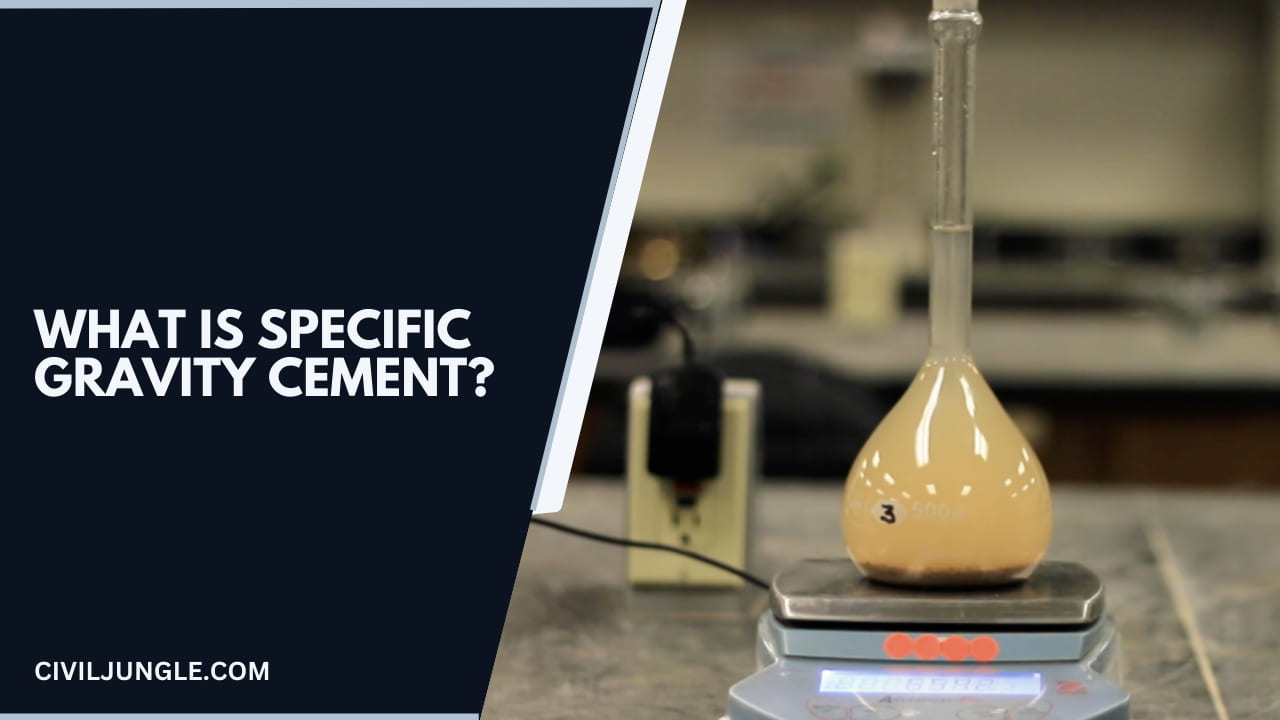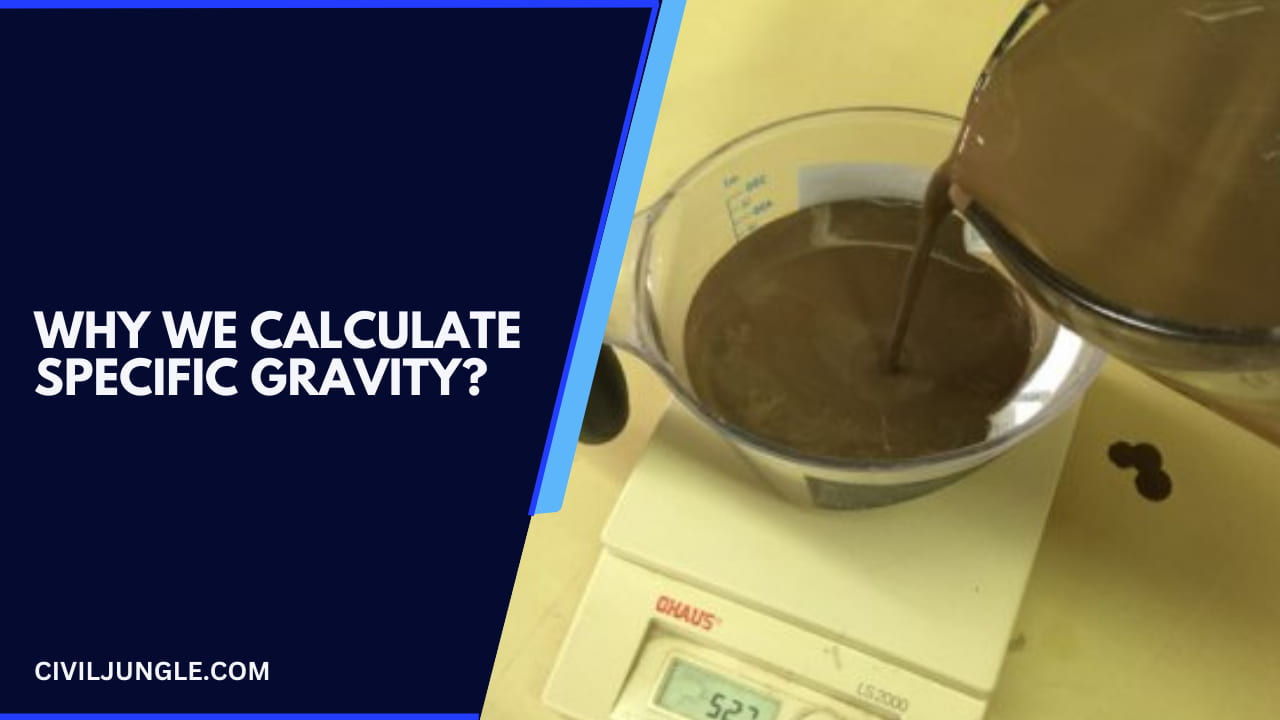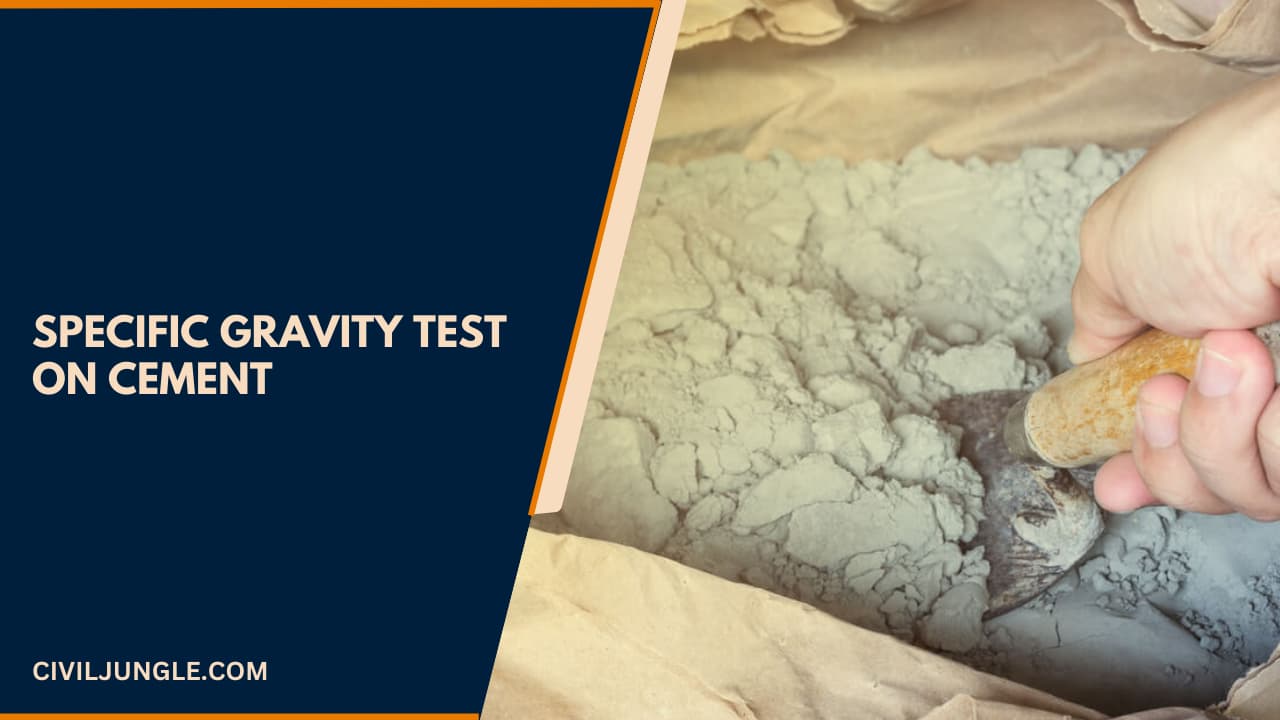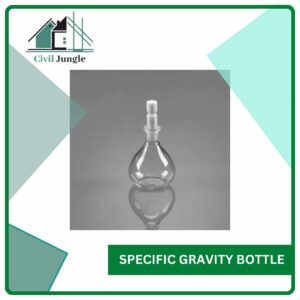What Is Specific Gravity Cement?
Important Point
Specific gravity is generally defined as the ratio between the mass of a given volume of material and mass of an equal volume of water. One of the methods of determining the specific gravity of cement is by the use of a liquid such as water-free kerosene, which does not react with cement.
A specific gravity bottle may be employed, or a standard Le Chatelier specific gravity flask may be used. In addition to hydraulic cement, the Le Chatelier specific gravity flask can also be used to obtain the specific gravity of dust, sand, and other fine materials.
This specific gravity of cement is a need for mixture-proportioning calculations. This specific gravity of portland cement (without voids between particles) is about 3.15 and can be determined according to ASTM C188.
This density of the bulk cement (including voids between particles) varies considerably, depending on how it is handled and stored. For example, vibration during transportation of bulk cement consolidates the cement and increases its bulk density. Thus, cement quantifies are specified and measured by weight rather than volume.
Specific Gravity of Cement
We know that specific gravity of cement or Density of cement is ranging between 3.1-3.16g/cc by this, cement is 3.16 times heavier than water of the same volume. For Nominal mix design, the specific gravity of cement should be 3.15g/cc. Every material has pores which may contain voids in it.
Also, read: What is Plum Concrete | Application | Mix Design | Methodology
Why We Calculate Specific Gravity?
The specific gravity of any substance to know the behavior of the material in water, and we can see the material will sink or floats in the water. All of the materials at our environment have a fixed specific gravity.
The usual range is 1-100. If the specific gravity isn’t less than 1, then it sinks in water. If the specific gravity isn’t greater than 1, it floats at the water. So if this specific gravity of any substance is known to us, we can use the materials in a suitable place of any work.
The specific gravity defines that the substance is how much heavier than water or reference substance of the same volume. This specific gravity of cement ranging from 3.1 to 3.16 g/cc. By this statement, we may ensure that cement 3.1-3.16 times heavier than this water of this same volume, and it sinks in water.
Because the specific gravity isn’t less than 1, every material consists of so many little pores, which can contain voids in it, and the material becomes useless when any void present in the material.
When a cement covered by extreme moisture content because of bad weather conditions, then a specific gravity of cement can go up to 3.19. If this specific gravity value reaches 3.19, then these pores at cement are filled with moisture.
The cement undergoes a chemical reaction when it reacts with this atmospheric moisture. The process is terminated as hydration. Moisture is very harmful to cement. Cement becomes useless once it is hydrated with water.
This presence of excessive moisture is the reason for finding a lot of lumps at old cement is due to content it.
Also, read: What Is Cover in Concrete | Clear Cover in Beams, Slab, Column, Footing
Specific Gravity Test on Cement
Apparatus for Specific Gravity Test on Cement
#1. Weighing Balance-
A weighing balance is a device to measure weight or mass. These are also known as mass scales, mass balance, weight scales, weight balance, or balance scale.
#2. Le Chatelier Specific Gravity Flask with a Ground Glass Stopper-
The Le Chatelier flask shown in as below fig. is made of thin glass having a bulb at this bottom. The capacity of this bulb is nearly 250 ml. The bulb is 78 mm in mean diameter. The stem is graduated milliliters; the small oval bulb in the neck holds 17 ml, below this bulb, are graduations from 0-1ml; above the bulb, the neck is graduate from 18-24 ml. This portion above the 24 ml mark is in the form of a funnel having a top diameter as 50 mm. Thus the total capacity of the stem of a bulb is 24 ml. A glass stopper or nipple is fitted in the stem to cover the flask.
#3. Specific Gravity Bottle-
Specific gravity bottles determine liquid densities by measuring the difference between an empty and filled bottle and dividing by an equal volume of water to find the specific gravity of the substance. These bottles are also known as a density bottle or relative-density bottles.
#4. Constant Temperature Water Bath-
The water bath is laboratory equipment made from a container filled with heated water. It is used to incubate samples at the water at a constant temperature over a long period of time.
Also, read: What Is Honeycomb In Concrete | Cause | Cure | Type of Grouting
Procedure Specific Gravity Test on Cement
Step 1: With a Specific Gravity Bottle
- Weigh the specific gravity bottle dry. Let the mass of the empty bottle be W1.
- Fill the bottle with distilled water and weigh. Let the mass be W2.
- Wipe dry the specific gravity bottle and fill it with kerosene and weigh. Let this mass be W3.
- Pour some of the kerosene out and introduce a weighed quantity of cement, W5 (about 50 g) into the bottle. Roll the bottle gently in an inclined position until no further air bubbles rise to the surface. Fill the bottle to the top with kerosene and weigh it. Let this mass be W4.
- From these data, calculate the specific gravity of the cement, S.
The specific gravity of kerosene, S = (W3 – W1) / (W2 – W1)
The volume of bottle = W2 – W1
The volume of cement = W5 /S
The volume of kerosene after the cement has been added = (W2 – W1) – W5 / S
Wherefrom mass of kerosene after the cement has been added = [ (W2 – W1) – W5 / S ] s
Therefore, [ ( W2 – W1) – W5 / S ] s + W5 + W1 = W4
Substituting the value of s sand on simplification,
-
-
- W5 / S = (W5 + W3 – W4) X {(W2 – W1) / (W3 – W1)}
-
Therefore, specific gravity of cement,
-
-
- S = [ W5 ( W3 – W1)] / [ (W5 + W3 – W4) x (W2 – W1)]
-
Also, read: What Is Workability of Concrete | Factors Affecting Workability | Test |Errors
Observations and Calculations
Step 2: With Le Chatelier flask
- Dry the flask carefully and fill with kerosene or Naphtha to a point on the stem between zero and 1 ml.
- Dry the inside of the flask above the level of the liquid.
- Immerse the flask in a constant temperature water bath maintained at room temperature for a sufficient period before taking any reading so as to avoid variation greater than 0.2°C in the temperature of the liquid in the flask.
- Record the level of the liquid in the flask as initial reading, V1.
- Place a weighed quantity of cement, W1 (about 60 g) into the flask so that the level of kerosene rises to about say 22 ml mark. Care is taken to avoid splashing and to see that cement does not adhere to the sides of the flask above the liquid.
- After putting all the cement into a flask, insert the nipple and roll the flask gently in an inclined position to free the cement from the air until no further air bubble rises to the surface of the liquid.
- Keep the flask back in a constant temperature water bath and note down the new liquid level as final reading, V2.
Calculate the specific gravity, S.
Also, read: Concrete Mix Ratio | What Is Concrete Mix Ratio | Type of Concrete Mix Ratio
Observations and Calculations
Precautions
The kerosene or Naphtha used should be free from water. The specific gravity bottle and the Le Chatelier flask should be held in a constant temperature water bath sufficiently long to ensure the same temperature before each weighing is made.
Duplicate determination of specific gravity should agree within 0.01. While introducing cement, care should be taken to avoid splashing and cement should not adhere to the inside of the flask above the liquid
Discussion
In case a specific gravity bottle shown in as per above fig. is used, it is necessary to determine the specific gravity of kerosene or other liquid used and all the measurements are made entirely by mass.
If Le Chatelier flask is used, some of the measurements are made by volume and it is not necessary to know the specific gravity of kerosene.
The relative density of kerosene is 0.8. The specific gravity of ordinary Portland cement is in the range of 2.15.
What Is Specific Gravity of Cement?
Basically, specific gravity defines that the substance is how much heavier than water or reference substance of the same volume. The specific gravity of cement ranging from 3.1 to 3.16 g/cc.
How Do You Calculate the Specific Gravity of Cement?
W3 = weight of flask + cement + kerosene. W4 = weight of flask + kerosene. 0.79= specific gravity of kerosene. Limit: Specific gravity of cement = 3.15 g/cc
Specific Gravity of Cement
The specific gravity of cement ranging from 3.1 to 3.16 g/cc. … If the cement covered by extreme moisture content due to bad weather conditions, then the specific gravity of cement may go up to 3.19. If the specific gravity value reaches 3.19, then the pores in cement are filled with the moisture.
Specific Gravity of OPC
Specific gravity of OPC is generally. 3.1 to 3.16 g/cc
Specific Gravity of Cement IS Code
As per Le Chatelier’s Principle, Specific gravity of cement is determined by Le Chatelier’s Flask method. And the IS code for Specific gravity test is IS 2720- Part 3.
Specific Gravity of PPC Cement
The specific gravity of OPC used in the study was about 3.06 gr/cm3, whereas for the PPC it was around 3.08 gr/cm3.
Specific Gravity of Concrete
Generally, the specific gravity of cement ranges from 3.1 to 3.16 g/cc. From this we can say that the specific gravity of cement is more than the specific gravity of water that is 1. It means cement will sink in water if we put on the water.
Specific Gravity of Cement Procedure
For Nominal mix design, the specific gravity of cement should be 3.15g/cc. Every material has pores which may contain voids in it. If the cement is exposed to extreme moisture content due to bad weather conditions, then the specific gravity of cement may go up to 3.19.
How to Find Specific Gravity?
The density of the object (x) divided by the density of water (1) gives us the specific gravity 0.8.
Why Kerosene Used for Specific Gravity Test of Cement?
We use kerosene for finding specific gravity in it. The reason behind this, cement hydrates and forms calcium oxide when it reacts with water. Cement won’t show any reaction when it mixed with kerosene.
Sp.Gravity of Cement
Limit: Specific gravity of cement = 3.15 g/cc.
Why Specific Gravity Test Is Done?
A urine specific gravity test compares the density of urine to the density of water. This quick test can help determine how well your kidneys are diluting your urine. Urine that’s too concentrated could mean that your kidneys aren’t functioning properly or that you aren’t drinking enough water.
What Is Standard Specific Gravity of Cement?
Basically, specific gravity defines that the substance is how much heavier than water or reference substance of the same volume. The specific gravity of cement ranging from 3.1 to 3.16 g/cc.
What Is the Use of Specific Gravity of Cement?
Specific gravity is an important property of cement being related to its density and viscosity. It is one of the factor to determine density of cement. If the specific gravity of cement is more than 3.19 then it has more moisture content, which will affect the mix and bonding.
Specific Gravity of Cement Test Procedure
Place a sample of cement upto half of the flask (about 50 gm) and weight with its stopper (W2). Add kerosene (polar liquid) to cement in flask till it is about half full. Mix thoroughly with glass rod to remove entrapped air. Continue stirring and add more kerosene till it is flush with the graduated mark.
How to Calculate Specific Gravity of Cement?
W3 = weight of flask + cement + kerosene. W4 = weight of flask + kerosene. 0.79 specific gravity of kerosene. Limit: Specific gravity of cement = 3.15 g/cc.
Lowest Specific Gravity Cement Types
The specific gravity of cement typically ranges between 3.10 to 3.16, which is considered relatively high. However, some specialized types of cement have lower specific gravity values. Here are a few examples:
- Oil well cement: Oil well cement is designed specifically for use in oil and gas well construction. It typically has a lower specific gravity compared to regular cement, ranging from 1.8 to 2.2.
- Lightweight cement: Lightweight cement is used in applications where a reduced weight of the concrete is desired. It incorporates lightweight aggregates such as expanded shale, clay, or slate to achieve a lower specific gravity, typically ranging from 1.2 to 2.0.
- Aerated cement: Aerated cement, also known as cellular concrete or foamed concrete, is a lightweight and highly insulating material. It is produced by introducing air or gas bubbles into a cement-based mixture. The specific gravity of aerated cement can vary depending on the density of the foam, but it generally falls within the range of 0.2 to 1.0.
Specific Gravity of Cement Industry Standards
The specific gravity of cement ranges from 3.1 to 3.16 g/cc. By this statement, we can ensure that cement is 3.1-3.16 times heavier than water of the same volume.
Specific Gravity Test for Cement
The specific gravity test is a common test conducted to determine the density or relative density of a material compared to the density of water. In the case of cement, the specific gravity test provides an indication of its quality and can be used to assess its composition and potential impurities.
Specific Weight of Cement
Basically, specific gravity defines that the substance is how much heavier than water or a reference substance of the same volume. The specific gravity of cement ranges from 3.1 to 3.16 g/cc. By this statement, we can ensure that cement is 3.1-3.16 times heavier than water of the same volume.
Why Kerosene Is Used in Specific Gravity of Cement?
In the case of cement, we use kerosene for finding specific gravity of it. Cement hydrates and forms calcium oxide when it reacts with water. Cement won’t show any type of reaction when it mixed with kerosene. Hence kerosene is used to find the specific gravity of cement instead of water.
How to Calculate Specific Gravity?
How to calculate and measure specific gravity. If the density of a substance is known, to calculate the specific gravity of a substance simply divide the density of the substance by the density of water or air. Because the density of water is 1000 kg/m3 or 1 g/cm3, it is simple to calculate.
Why Specific Gravity of Cement Is Important?
Cement’s specific gravity is correlated with its density and viscosity, making it an essential characteristic. It has a role in establishing the cement’s density. Cement with a specific gravity over 3.19 contains more moisture than is ideal for mixing and bonding.
What Is the Use of Specific Gravity of Cement?
Specific gravity separates bad particles which are lighter than other particles, from good aggregates. Using specific gravity in cement mix design, we calculate the solid volume of aggregates in concrete mix. Gavel, water and cement are used for this test.
Specific Gravity of Cement Test Apparatus
Object: To determine the specific gravity of cement using Le Chatelier Flask or Spcefic Gravity Bottle. Apparatus: a) Le Chatelier Flask or Specific Gravity Bottle – 100 ml capacity. b) Balance capable of weighing accurately upto 0.1gm.
Specific Gravity and Water Absorption Test
The specific gravity test helps in the identification of stone. Water absorption gives an idea of strength of aggregate. Aggregates having more water absorption are more porous in nature and are generally considered unsuitable unless they are found to be acceptable based on strength, impact and hardness tests.
Specific Gravity Determination
Specific gravity is determined by dividing the density of a material by the density of water at 4 degrees Celsius. For the calculation, the density of the material and that of the water must be expressed in the same units.
Like this post? Share it with your friends!
Suggested Read –
- Cement Finishes
- Cement Finish Wall
- Unit Weight of Cement
- What is Consistency of Cement
- How to Calculate Load on Beam
- What Is Cement | Type of Cement
- What Is Soundness of Cement Test
- Top 10 Construction Companies in India
- Rate Analysis of RCC (Reinforcement Cement Concrete)
- Difference Between One Way Slab and Two Way Slab | What is Slab
- What Is Structural Settlement | Causes For Structural Settlement | What Is Soil Settlement & Foundation Structural Settlement
Originally posted 2023-07-04 11:45:17.












Leave a Reply